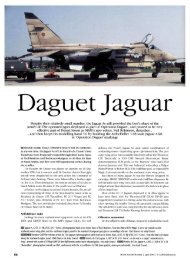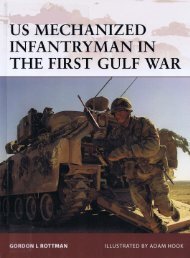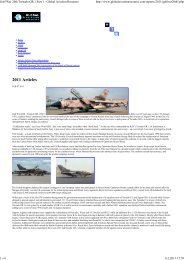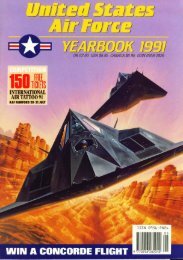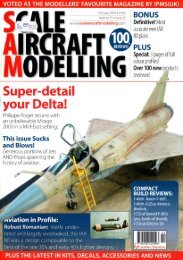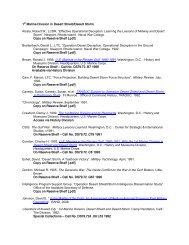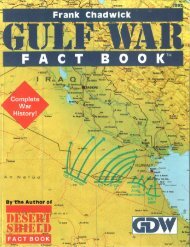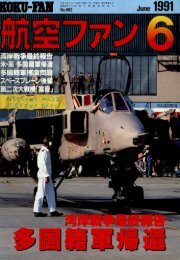The Road to Safwan: The 1st Squadron, 4th Cavalry in the 1991 ...
The Road to Safwan: The 1st Squadron, 4th Cavalry in the 1991 ...
The Road to Safwan: The 1st Squadron, 4th Cavalry in the 1991 ...
Create successful ePaper yourself
Turn your PDF publications into a flip-book with our unique Google optimized e-Paper software.
64 <strong>The</strong> <strong>Road</strong> <strong>to</strong> <strong>Safwan</strong><br />
assembly area with <strong>the</strong> rema<strong>in</strong>der of <strong>the</strong> Aviation Brigade’s aviation<br />
units. <strong>The</strong> aviation troops’ assembly area consisted of<br />
sand walls, called berms, orig<strong>in</strong>ally constructed <strong>to</strong> protect <strong>the</strong><br />
helicopters from observation and artillery. <strong>The</strong> eng<strong>in</strong>eers had<br />
anchored steel tie-downs <strong>in</strong><strong>to</strong> <strong>the</strong> ground for <strong>the</strong> aircraft <strong>to</strong> prevent<br />
damage <strong>in</strong> case of high w<strong>in</strong>ds. However, as it turned out,<br />
<strong>the</strong> berms were <strong>to</strong>o small <strong>to</strong> accommodate <strong>the</strong> aircraft, so <strong>the</strong>y<br />
became <strong>the</strong> aviation troops’ temporary home. <strong>The</strong> squadron’s<br />
twenty-one aircraft departed on <strong>the</strong> morn<strong>in</strong>g of January 20,<br />
and, after mak<strong>in</strong>g one s<strong>to</strong>p at Assembly Area Bas<strong>to</strong>gne, all arrived<br />
at <strong>the</strong> Aviation Brigade’s assembly area around 1530<br />
hours that afternoon. 21<br />
Now that much of <strong>the</strong> squadron’s combat power was <strong>in</strong><br />
TAA Roosevelt, its emphasis shifted <strong>to</strong> tra<strong>in</strong><strong>in</strong>g and weapons<br />
test fir<strong>in</strong>g and zero<strong>in</strong>g. <strong>The</strong> troopers <strong>to</strong>ok every opportunity <strong>to</strong><br />
hone <strong>the</strong>ir combat skills. Sergeants directed <strong>in</strong>dividual soldiers,<br />
generally cover<strong>in</strong>g both survival skills, such as preparation for<br />
a chemical attack, and combat skills, such as fir<strong>in</strong>g weapons<br />
and determ<strong>in</strong><strong>in</strong>g if <strong>the</strong> vehicle <strong>in</strong> front of you was enemy or<br />
friendly. Sergeants also supervised collective, or group, tra<strong>in</strong><strong>in</strong>g<br />
at <strong>the</strong> crew and section level, s<strong>in</strong>ce a tank, Bradley, or mortar<br />
crew had <strong>to</strong> function as a team <strong>to</strong> succeed. 2LT Gerardo Cartegena,<br />
<strong>the</strong> squadron chemical officer, was <strong>in</strong> high demand as a<br />
tra<strong>in</strong><strong>in</strong>g advisor as <strong>the</strong> troops emphasized <strong>the</strong> possibility of a<br />
chemical attack <strong>in</strong> both <strong>the</strong>ir tra<strong>in</strong><strong>in</strong>g and wartime plann<strong>in</strong>g.<br />
<strong>The</strong> squadron leaders practiced with <strong>the</strong> new GPS. In what<br />
was an amaz<strong>in</strong>g transformation from <strong>the</strong> World War II era of<br />
map and compass, <strong>the</strong> opera<strong>to</strong>r simply entered <strong>the</strong> location of<br />
his dest<strong>in</strong>ation and followed directions. <strong>The</strong> GPS was extremely<br />
effective and allowed <strong>the</strong> ground units <strong>to</strong> maneuver with impunity<br />
over <strong>the</strong> battlefield, without worry<strong>in</strong>g about landmarks<br />
and compass head<strong>in</strong>gs. <strong>The</strong>re were never enough of <strong>the</strong>se precious<br />
devices. In B Troop, for example, <strong>the</strong>re were only six: one<br />
each for <strong>the</strong> commander, executive officer, first sergeant, and<br />
each of <strong>the</strong> three pla<strong>to</strong>on leaders. Even with this shortage, CPT<br />
Bills later considered it one of his most important systems. 22<br />
In <strong>the</strong> desert near <strong>the</strong> enemy l<strong>in</strong>es, crews had a chance <strong>to</strong><br />
fire service ammunition for <strong>the</strong> first time. Service, or wartime,<br />
ammunition has a different feel than tra<strong>in</strong><strong>in</strong>g ammunition



